Taxation Law: Analysis of CGT Events and Harrison Carter's Tax Return
VerifiedAdded on 2022/09/06
|8
|1238
|17
Report
AI Summary
This report analyzes the timing of a CGT event and advises on Harrison Carter's tax return for the years ending 2018 and 2019, as per the CLWM4100 Taxation Law assignment brief. The report explains the relevant sections of the Income Tax Assessment Act 1997 (ITAA 1997) and related case laws, such as FCT v Sara Lee Household & Body Care P/L (2000) and McDonald v FCT (1998), to determine the timing of a CGT event. It also covers the calculation of capital gains and losses arising from the sale of an investment property and shares, considering all available methods. The report also addresses the use of capital losses to offset capital gains. The report provides a comprehensive overview of CGT principles and their application to the given scenario, including the implications for Harrison Carter's tax liability. The report also includes relevant references for further study.
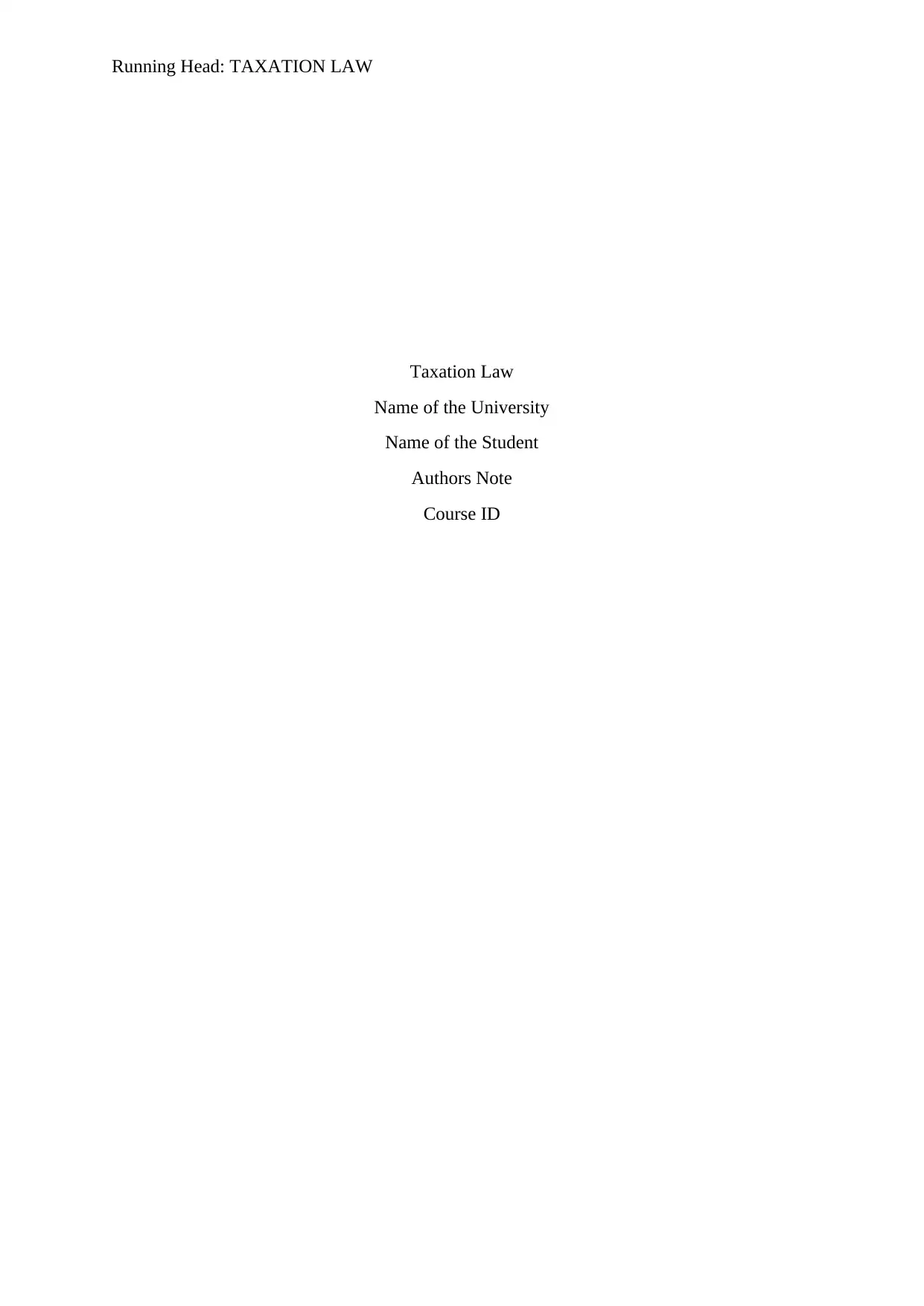
Running Head: TAXATION LAW
Taxation Law
Name of the University
Name of the Student
Authors Note
Course ID
Taxation Law
Name of the University
Name of the Student
Authors Note
Course ID
Paraphrase This Document
Need a fresh take? Get an instant paraphrase of this document with our AI Paraphraser
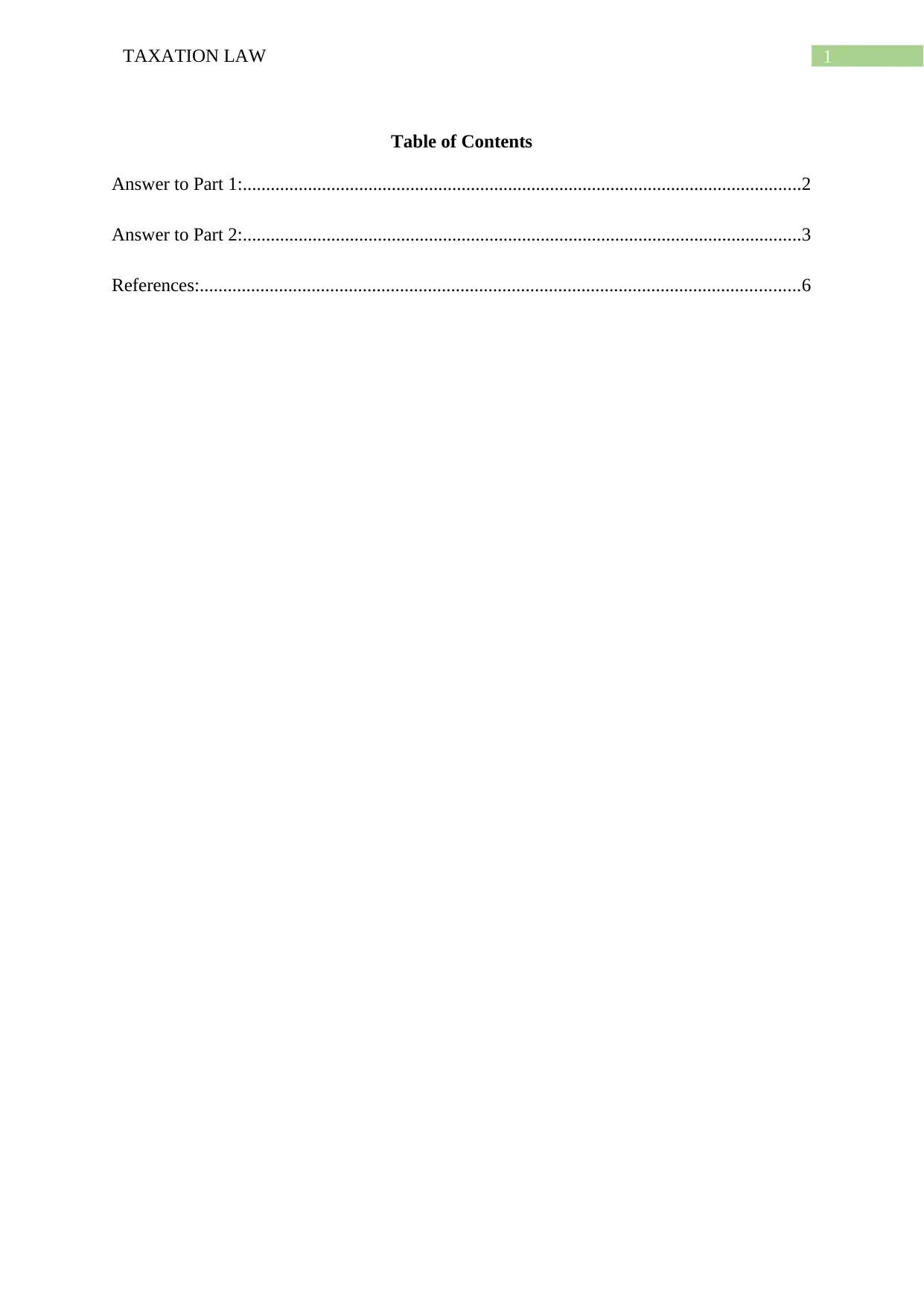
1TAXATION LAW
Table of Contents
Answer to Part 1:........................................................................................................................2
Answer to Part 2:........................................................................................................................3
References:.................................................................................................................................6
Table of Contents
Answer to Part 1:........................................................................................................................2
Answer to Part 2:........................................................................................................................3
References:.................................................................................................................................6
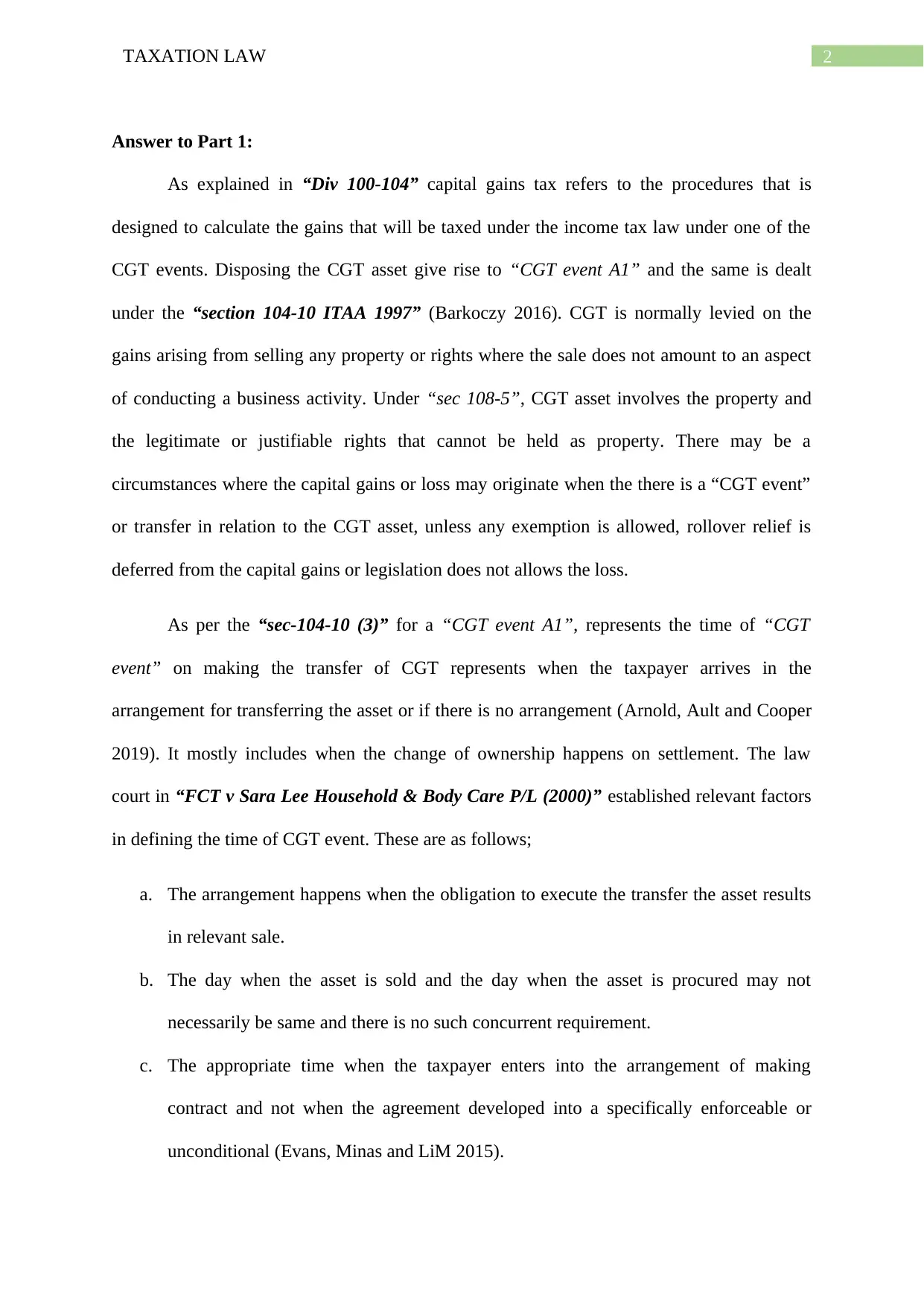
2TAXATION LAW
Answer to Part 1:
As explained in “Div 100-104” capital gains tax refers to the procedures that is
designed to calculate the gains that will be taxed under the income tax law under one of the
CGT events. Disposing the CGT asset give rise to “CGT event A1” and the same is dealt
under the “section 104-10 ITAA 1997” (Barkoczy 2016). CGT is normally levied on the
gains arising from selling any property or rights where the sale does not amount to an aspect
of conducting a business activity. Under “sec 108-5”, CGT asset involves the property and
the legitimate or justifiable rights that cannot be held as property. There may be a
circumstances where the capital gains or loss may originate when the there is a “CGT event”
or transfer in relation to the CGT asset, unless any exemption is allowed, rollover relief is
deferred from the capital gains or legislation does not allows the loss.
As per the “sec-104-10 (3)” for a “CGT event A1”, represents the time of “CGT
event” on making the transfer of CGT represents when the taxpayer arrives in the
arrangement for transferring the asset or if there is no arrangement (Arnold, Ault and Cooper
2019). It mostly includes when the change of ownership happens on settlement. The law
court in “FCT v Sara Lee Household & Body Care P/L (2000)” established relevant factors
in defining the time of CGT event. These are as follows;
a. The arrangement happens when the obligation to execute the transfer the asset results
in relevant sale.
b. The day when the asset is sold and the day when the asset is procured may not
necessarily be same and there is no such concurrent requirement.
c. The appropriate time when the taxpayer enters into the arrangement of making
contract and not when the agreement developed into a specifically enforceable or
unconditional (Evans, Minas and LiM 2015).
Answer to Part 1:
As explained in “Div 100-104” capital gains tax refers to the procedures that is
designed to calculate the gains that will be taxed under the income tax law under one of the
CGT events. Disposing the CGT asset give rise to “CGT event A1” and the same is dealt
under the “section 104-10 ITAA 1997” (Barkoczy 2016). CGT is normally levied on the
gains arising from selling any property or rights where the sale does not amount to an aspect
of conducting a business activity. Under “sec 108-5”, CGT asset involves the property and
the legitimate or justifiable rights that cannot be held as property. There may be a
circumstances where the capital gains or loss may originate when the there is a “CGT event”
or transfer in relation to the CGT asset, unless any exemption is allowed, rollover relief is
deferred from the capital gains or legislation does not allows the loss.
As per the “sec-104-10 (3)” for a “CGT event A1”, represents the time of “CGT
event” on making the transfer of CGT represents when the taxpayer arrives in the
arrangement for transferring the asset or if there is no arrangement (Arnold, Ault and Cooper
2019). It mostly includes when the change of ownership happens on settlement. The law
court in “FCT v Sara Lee Household & Body Care P/L (2000)” established relevant factors
in defining the time of CGT event. These are as follows;
a. The arrangement happens when the obligation to execute the transfer the asset results
in relevant sale.
b. The day when the asset is sold and the day when the asset is procured may not
necessarily be same and there is no such concurrent requirement.
c. The appropriate time when the taxpayer enters into the arrangement of making
contract and not when the agreement developed into a specifically enforceable or
unconditional (Evans, Minas and LiM 2015).
⊘ This is a preview!⊘
Do you want full access?
Subscribe today to unlock all pages.

Trusted by 1+ million students worldwide
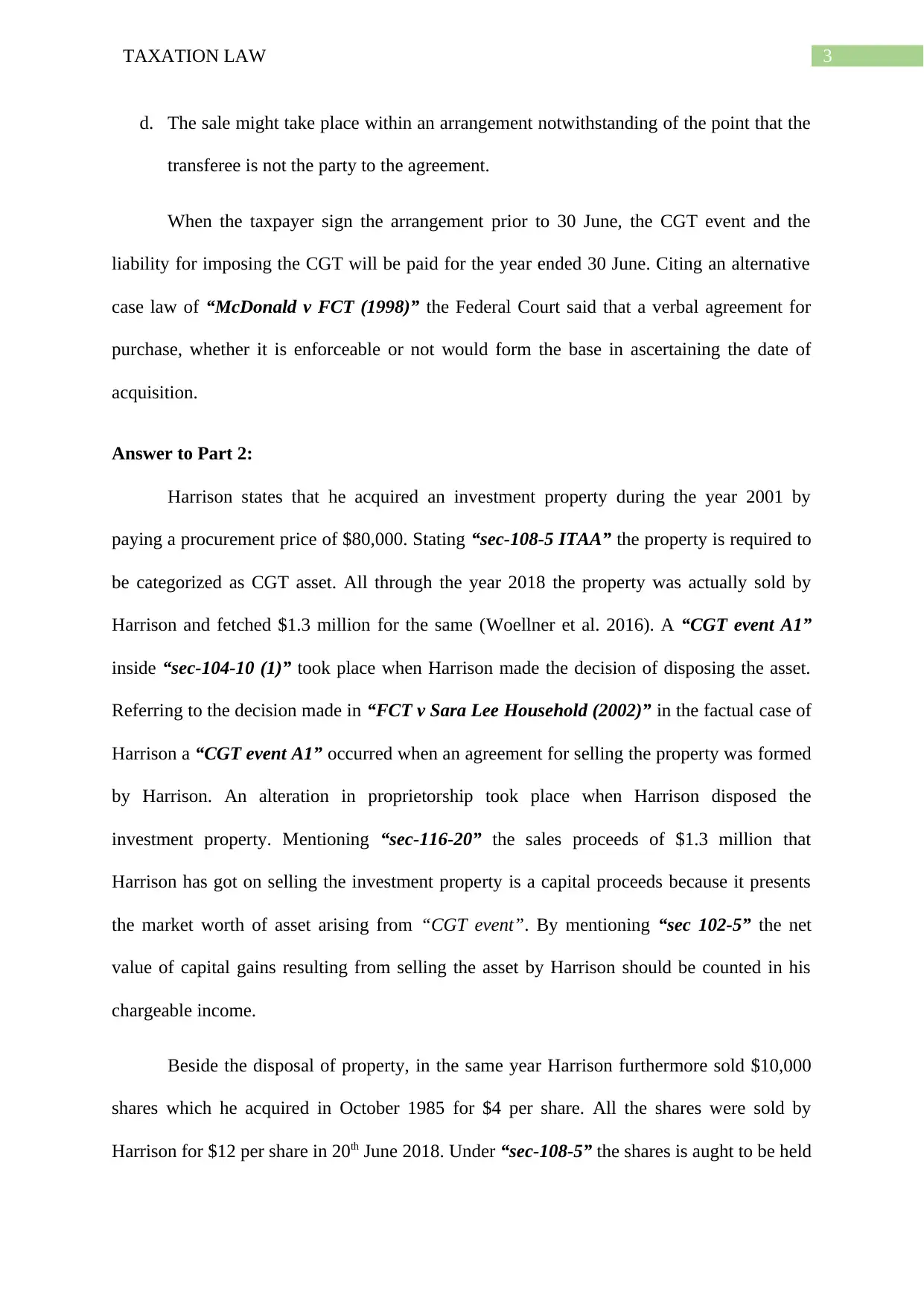
3TAXATION LAW
d. The sale might take place within an arrangement notwithstanding of the point that the
transferee is not the party to the agreement.
When the taxpayer sign the arrangement prior to 30 June, the CGT event and the
liability for imposing the CGT will be paid for the year ended 30 June. Citing an alternative
case law of “McDonald v FCT (1998)” the Federal Court said that a verbal agreement for
purchase, whether it is enforceable or not would form the base in ascertaining the date of
acquisition.
Answer to Part 2:
Harrison states that he acquired an investment property during the year 2001 by
paying a procurement price of $80,000. Stating “sec-108-5 ITAA” the property is required to
be categorized as CGT asset. All through the year 2018 the property was actually sold by
Harrison and fetched $1.3 million for the same (Woellner et al. 2016). A “CGT event A1”
inside “sec-104-10 (1)” took place when Harrison made the decision of disposing the asset.
Referring to the decision made in “FCT v Sara Lee Household (2002)” in the factual case of
Harrison a “CGT event A1” occurred when an agreement for selling the property was formed
by Harrison. An alteration in proprietorship took place when Harrison disposed the
investment property. Mentioning “sec-116-20” the sales proceeds of $1.3 million that
Harrison has got on selling the investment property is a capital proceeds because it presents
the market worth of asset arising from “CGT event”. By mentioning “sec 102-5” the net
value of capital gains resulting from selling the asset by Harrison should be counted in his
chargeable income.
Beside the disposal of property, in the same year Harrison furthermore sold $10,000
shares which he acquired in October 1985 for $4 per share. All the shares were sold by
Harrison for $12 per share in 20th June 2018. Under “sec-108-5” the shares is aught to be held
d. The sale might take place within an arrangement notwithstanding of the point that the
transferee is not the party to the agreement.
When the taxpayer sign the arrangement prior to 30 June, the CGT event and the
liability for imposing the CGT will be paid for the year ended 30 June. Citing an alternative
case law of “McDonald v FCT (1998)” the Federal Court said that a verbal agreement for
purchase, whether it is enforceable or not would form the base in ascertaining the date of
acquisition.
Answer to Part 2:
Harrison states that he acquired an investment property during the year 2001 by
paying a procurement price of $80,000. Stating “sec-108-5 ITAA” the property is required to
be categorized as CGT asset. All through the year 2018 the property was actually sold by
Harrison and fetched $1.3 million for the same (Woellner et al. 2016). A “CGT event A1”
inside “sec-104-10 (1)” took place when Harrison made the decision of disposing the asset.
Referring to the decision made in “FCT v Sara Lee Household (2002)” in the factual case of
Harrison a “CGT event A1” occurred when an agreement for selling the property was formed
by Harrison. An alteration in proprietorship took place when Harrison disposed the
investment property. Mentioning “sec-116-20” the sales proceeds of $1.3 million that
Harrison has got on selling the investment property is a capital proceeds because it presents
the market worth of asset arising from “CGT event”. By mentioning “sec 102-5” the net
value of capital gains resulting from selling the asset by Harrison should be counted in his
chargeable income.
Beside the disposal of property, in the same year Harrison furthermore sold $10,000
shares which he acquired in October 1985 for $4 per share. All the shares were sold by
Harrison for $12 per share in 20th June 2018. Under “sec-108-5” the shares is aught to be held
Paraphrase This Document
Need a fresh take? Get an instant paraphrase of this document with our AI Paraphraser
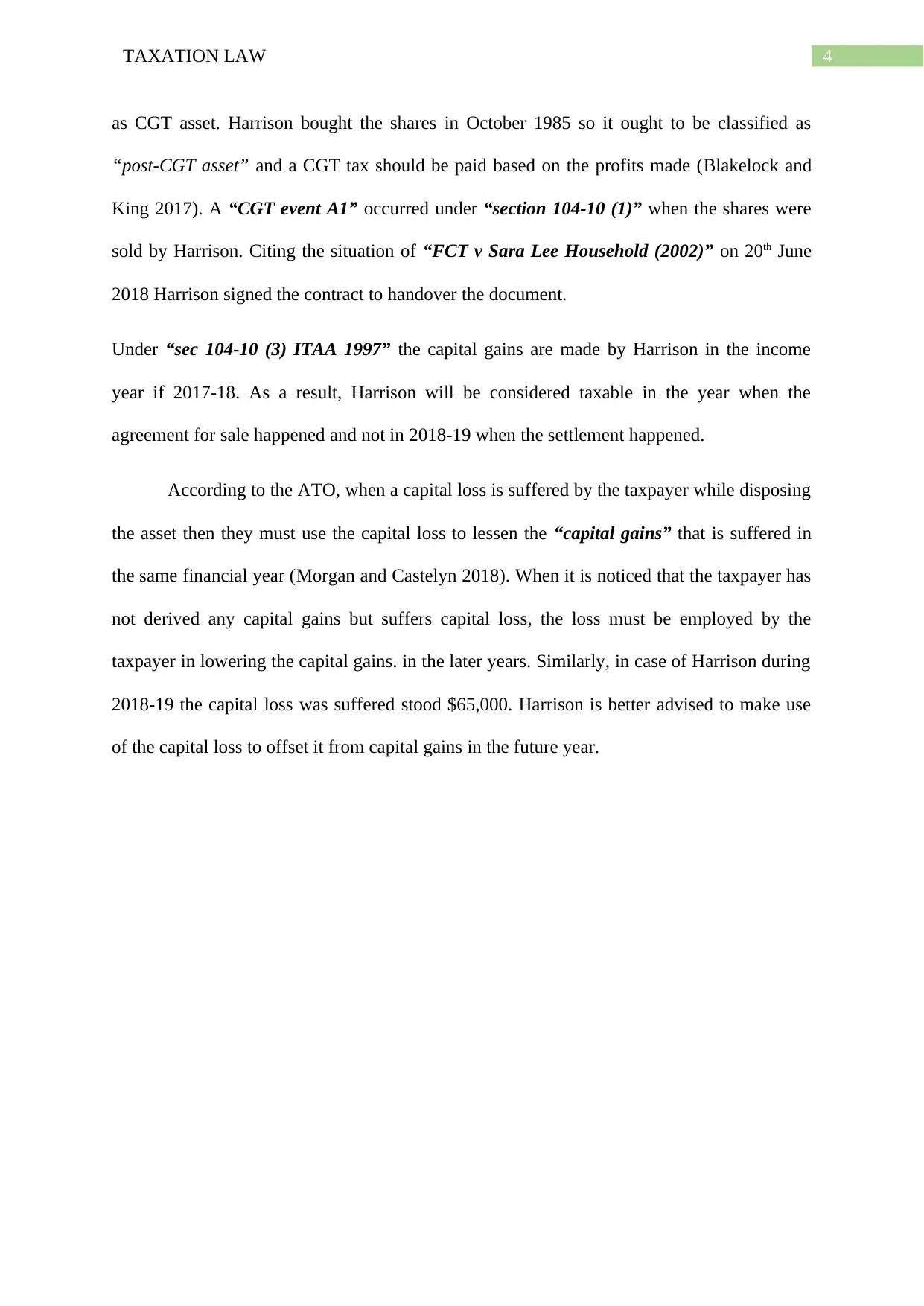
4TAXATION LAW
as CGT asset. Harrison bought the shares in October 1985 so it ought to be classified as
“post-CGT asset” and a CGT tax should be paid based on the profits made (Blakelock and
King 2017). A “CGT event A1” occurred under “section 104-10 (1)” when the shares were
sold by Harrison. Citing the situation of “FCT v Sara Lee Household (2002)” on 20th June
2018 Harrison signed the contract to handover the document.
Under “sec 104-10 (3) ITAA 1997” the capital gains are made by Harrison in the income
year if 2017-18. As a result, Harrison will be considered taxable in the year when the
agreement for sale happened and not in 2018-19 when the settlement happened.
According to the ATO, when a capital loss is suffered by the taxpayer while disposing
the asset then they must use the capital loss to lessen the “capital gains” that is suffered in
the same financial year (Morgan and Castelyn 2018). When it is noticed that the taxpayer has
not derived any capital gains but suffers capital loss, the loss must be employed by the
taxpayer in lowering the capital gains. in the later years. Similarly, in case of Harrison during
2018-19 the capital loss was suffered stood $65,000. Harrison is better advised to make use
of the capital loss to offset it from capital gains in the future year.
as CGT asset. Harrison bought the shares in October 1985 so it ought to be classified as
“post-CGT asset” and a CGT tax should be paid based on the profits made (Blakelock and
King 2017). A “CGT event A1” occurred under “section 104-10 (1)” when the shares were
sold by Harrison. Citing the situation of “FCT v Sara Lee Household (2002)” on 20th June
2018 Harrison signed the contract to handover the document.
Under “sec 104-10 (3) ITAA 1997” the capital gains are made by Harrison in the income
year if 2017-18. As a result, Harrison will be considered taxable in the year when the
agreement for sale happened and not in 2018-19 when the settlement happened.
According to the ATO, when a capital loss is suffered by the taxpayer while disposing
the asset then they must use the capital loss to lessen the “capital gains” that is suffered in
the same financial year (Morgan and Castelyn 2018). When it is noticed that the taxpayer has
not derived any capital gains but suffers capital loss, the loss must be employed by the
taxpayer in lowering the capital gains. in the later years. Similarly, in case of Harrison during
2018-19 the capital loss was suffered stood $65,000. Harrison is better advised to make use
of the capital loss to offset it from capital gains in the future year.
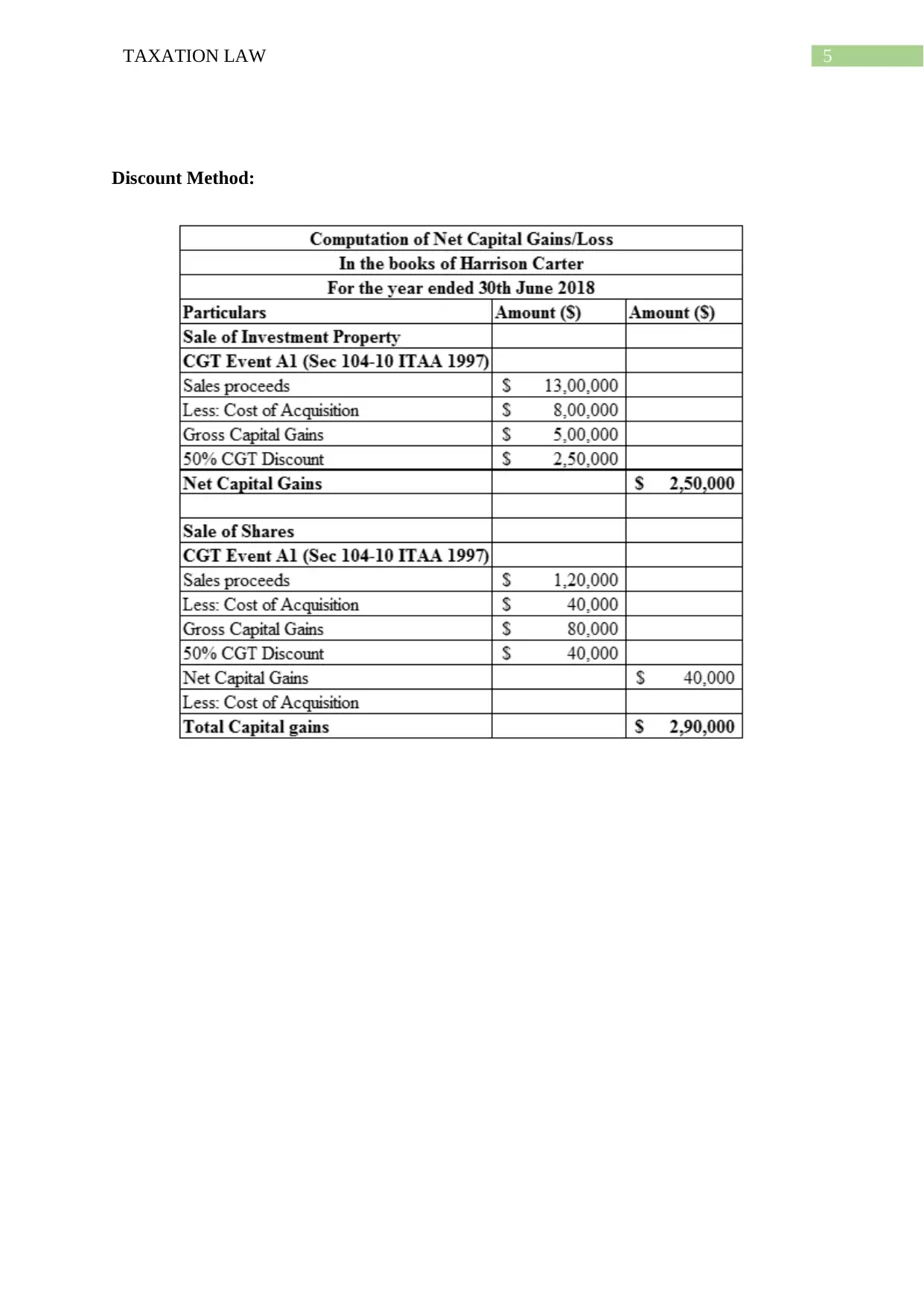
5TAXATION LAW
Discount Method:
Discount Method:
⊘ This is a preview!⊘
Do you want full access?
Subscribe today to unlock all pages.

Trusted by 1+ million students worldwide
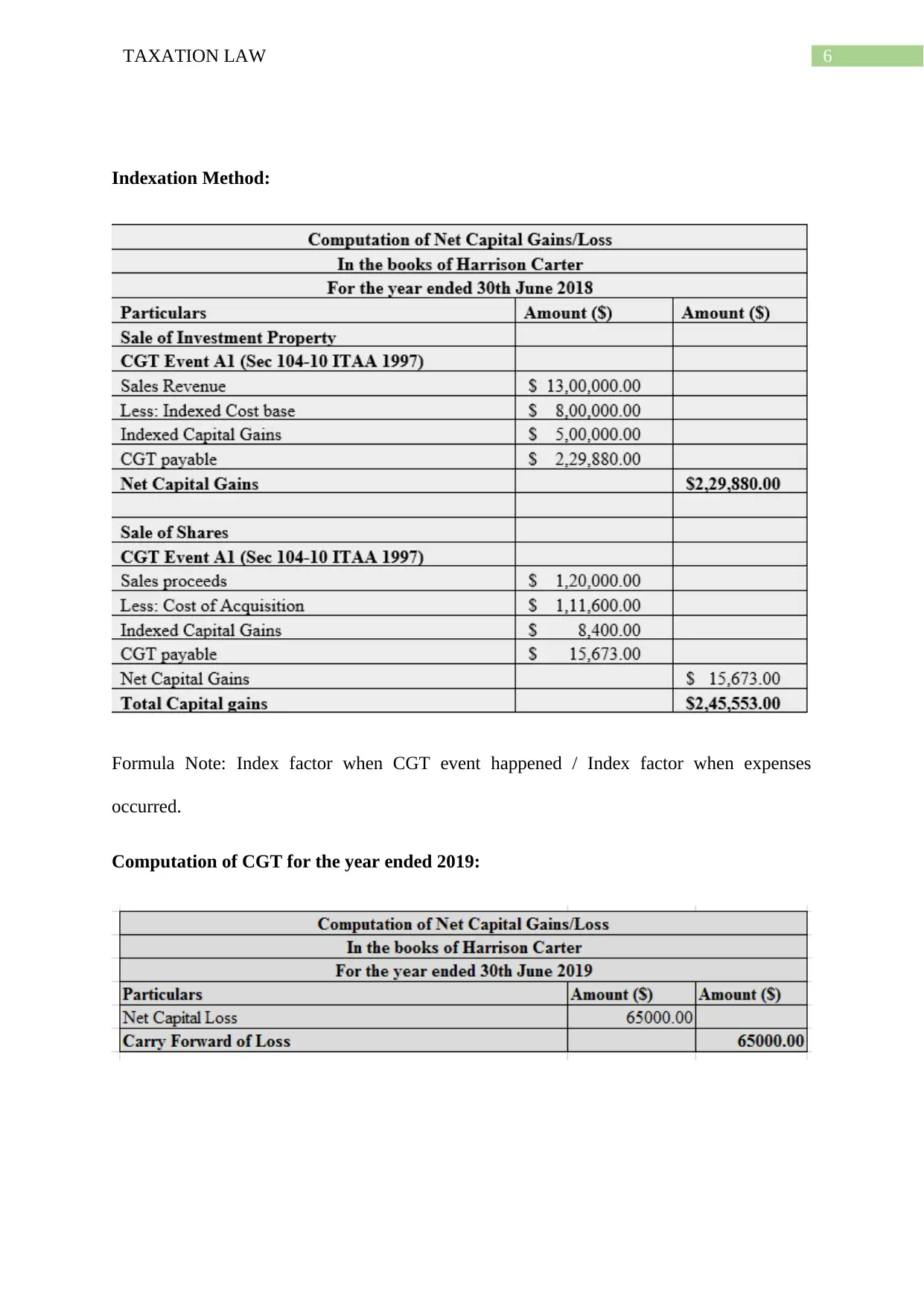
6TAXATION LAW
Indexation Method:
Formula Note: Index factor when CGT event happened / Index factor when expenses
occurred.
Computation of CGT for the year ended 2019:
Indexation Method:
Formula Note: Index factor when CGT event happened / Index factor when expenses
occurred.
Computation of CGT for the year ended 2019:
Paraphrase This Document
Need a fresh take? Get an instant paraphrase of this document with our AI Paraphraser
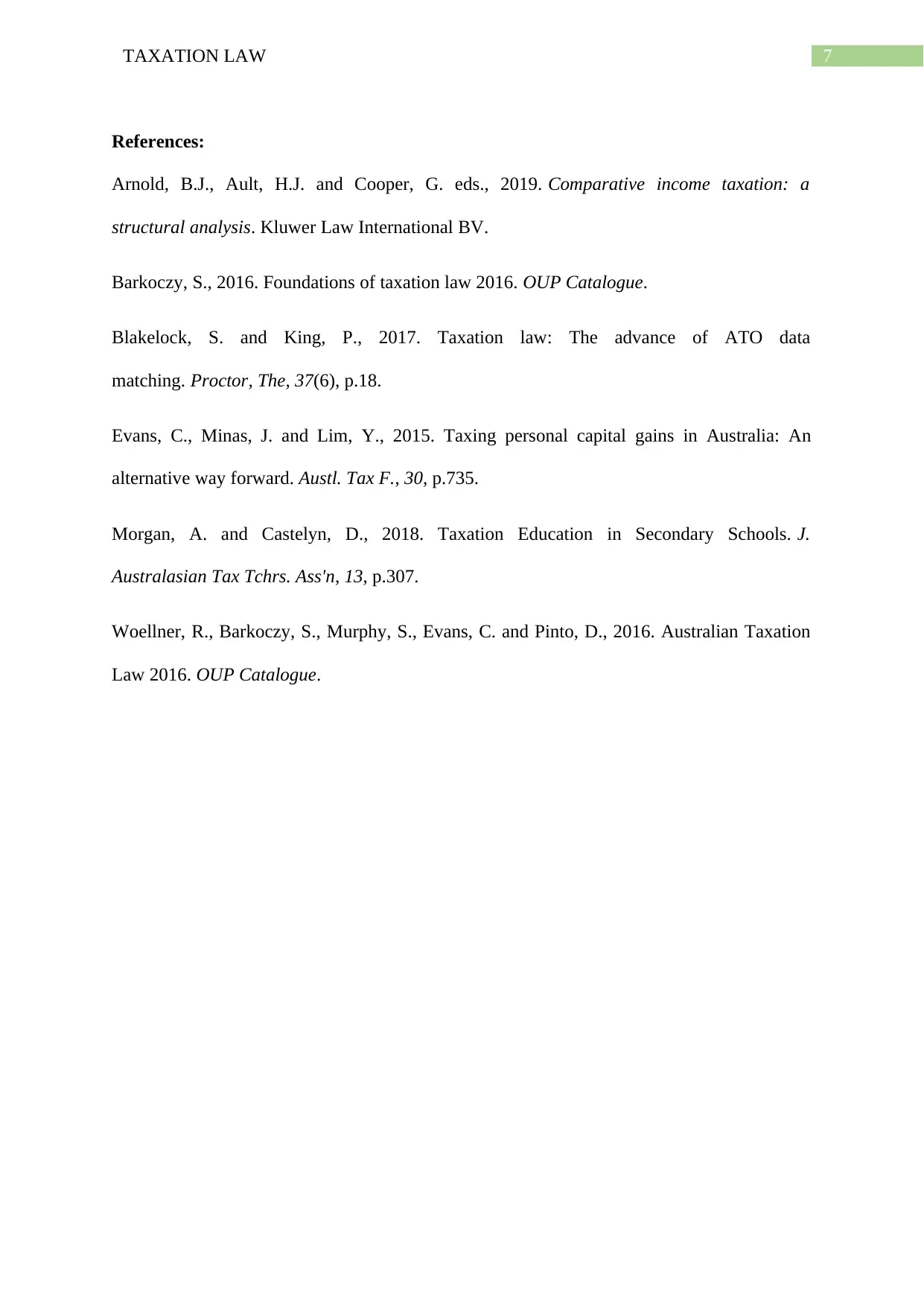
7TAXATION LAW
References:
Arnold, B.J., Ault, H.J. and Cooper, G. eds., 2019. Comparative income taxation: a
structural analysis. Kluwer Law International BV.
Barkoczy, S., 2016. Foundations of taxation law 2016. OUP Catalogue.
Blakelock, S. and King, P., 2017. Taxation law: The advance of ATO data
matching. Proctor, The, 37(6), p.18.
Evans, C., Minas, J. and Lim, Y., 2015. Taxing personal capital gains in Australia: An
alternative way forward. Austl. Tax F., 30, p.735.
Morgan, A. and Castelyn, D., 2018. Taxation Education in Secondary Schools. J.
Australasian Tax Tchrs. Ass'n, 13, p.307.
Woellner, R., Barkoczy, S., Murphy, S., Evans, C. and Pinto, D., 2016. Australian Taxation
Law 2016. OUP Catalogue.
References:
Arnold, B.J., Ault, H.J. and Cooper, G. eds., 2019. Comparative income taxation: a
structural analysis. Kluwer Law International BV.
Barkoczy, S., 2016. Foundations of taxation law 2016. OUP Catalogue.
Blakelock, S. and King, P., 2017. Taxation law: The advance of ATO data
matching. Proctor, The, 37(6), p.18.
Evans, C., Minas, J. and Lim, Y., 2015. Taxing personal capital gains in Australia: An
alternative way forward. Austl. Tax F., 30, p.735.
Morgan, A. and Castelyn, D., 2018. Taxation Education in Secondary Schools. J.
Australasian Tax Tchrs. Ass'n, 13, p.307.
Woellner, R., Barkoczy, S., Murphy, S., Evans, C. and Pinto, D., 2016. Australian Taxation
Law 2016. OUP Catalogue.
1 out of 8
Related Documents
Your All-in-One AI-Powered Toolkit for Academic Success.
+13062052269
info@desklib.com
Available 24*7 on WhatsApp / Email
![[object Object]](/_next/static/media/star-bottom.7253800d.svg)
Unlock your academic potential
Copyright © 2020–2025 A2Z Services. All Rights Reserved. Developed and managed by ZUCOL.





